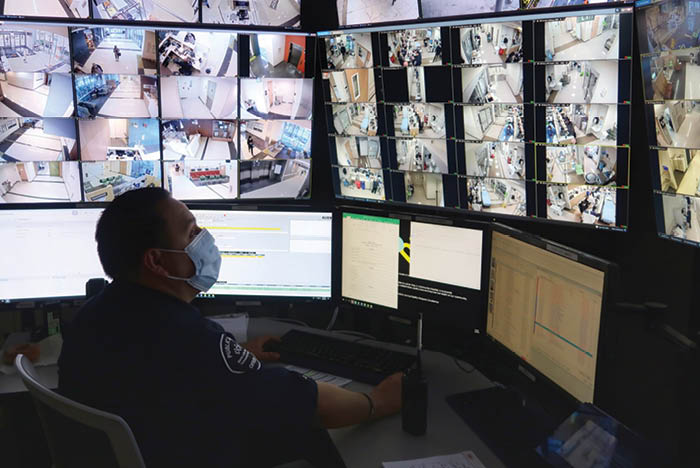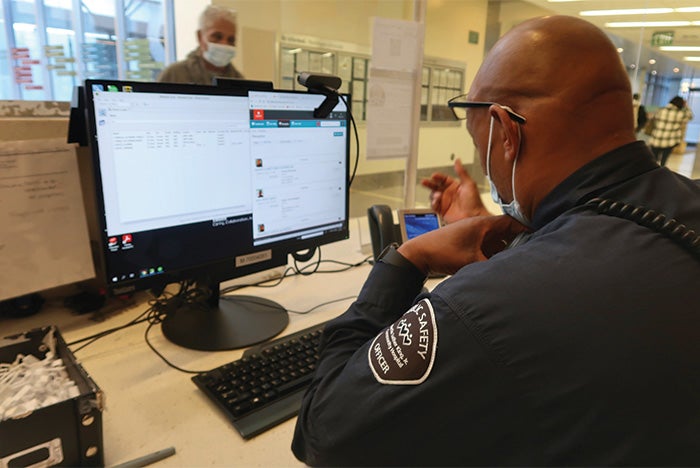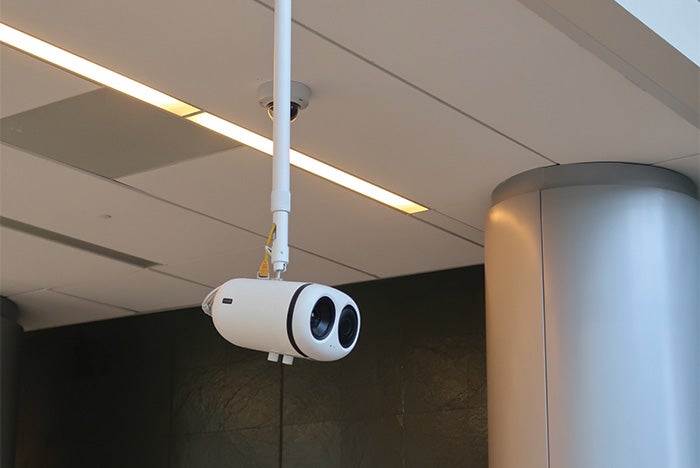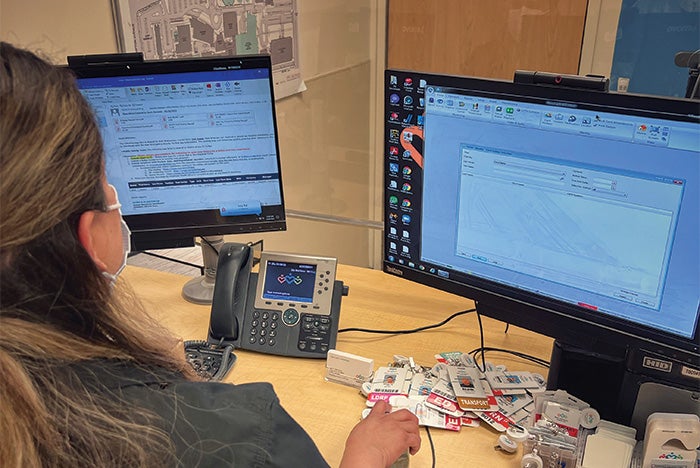Leveraging technology to reduce safety incidents

A public safety officer monitors cameras at Martin Luther King, Jr. Community Hospital in Los Angeles.
Photo by Mark Reed, CHPA
Given the high demand for health care services and the capacity issues in health care environments, it’s never been more important to utilize available technology to reduce incidents of all kinds in the hospital environment.
The ever-changing circumstances have made it necessary to put in place new security protocols, limit the spread of infectious diseases like COVID-19 and allow for a safer, more comfortable environment. Beyond the protocols, proper operational technology is vital to ensuring the safety and comfort of patients and loved ones.
In the past few years, the world has seen how technology has aided in contact tracing, security developments and the constant spread of information. These are just a few examples of automation that have helped humanity survive a global pandemic.
While it would be ideal for facilities to institute most technological advances with no concern for cost, that scenario is not realistic. Fortunately, implementing even a few lower-cost measures can prove helpful in reducing or even stopping incidents.
Daily monitoring technologies
Technology plays an important role in a facility’s day-to-day operations. Ensuring notifications are made is vital even when an emergency is not occurring. Because hospitals deal in life-and-death scenarios, proper alerts must ensure staff members know what each patient requires (and when) and that all processes are running smoothly. If not, situations can quickly escalate. Some of the key technologies for daily security include the following:

A public safety officer processes a visitor at the Martin Luther King, Jr. facility.
Photo by Mark Reed, CHPA
- Security checkpoints and screening. First and foremost, a health care facility must ensure that daily security monitoring is up to par. Monitoring precisely who and what enters the property is the first defense a hospital has against incidents of any kind. Metal detectors can be a part of that first defense — they create a checkpoint for anyone entering the property and deter would-be criminals from potentially entering in the first place.
Having a security checkpoint at every accessible entrance is vital. Fortunately, screening checkpoints don’t have to come at a high cost. A few smaller measures, while sometimes a bit time-consuming, can prove effective. For example, while walk-through detectors tend to be the most accurate readers, trained personnel with hand-held metal detectors also can be effective. Hand-held metal detector wands can cost as little as $20 each. Utilizing these inexpensive security devices can aid in deterring potential incidents.
When a facility is especially busy, it can be challenging to do more than ensure anyone passing through the entrance is free of weapons; however, knowing who is entering the facility is especially vital for many reasons. Patients often are incapacitated and cannot protect themselves; children may be in rooms alone for periods of time; and stations might be undergoing a shift change. These are all instances that could allow dangerous situations to play out and are sometimes unavoidable.
Ideally, screening would only be necessary for visitors; however, hospital patients and staff should be adequately screened, too. For example, a posting on Lowers & Associates from prior to the pandemic listed statistics showing 80% of violent encounters with health care personnel were caused by patients. Likewise, criminal incidents may have occurred on the part of staff members after their most recent background check.
Security staff should be patrolling the perimeter of the facility and routinely checking the grounds for any suspicious items, people hiding in blind spots and anything that looks “off.” Security staff also should look inside vehicles for questionable items, people sleeping and other occurrences that do not feel safe. Some of the most notorious criminals in history have been put behind bars because of mistakes as simple as expired registration causing them to be pulled over.

A temperature camera that observes people entering the building.
Photo by Mark Reed, CHPA
- Video detection and monitoring. As with any facility that contains sensitive information or materials, video monitoring is necessary. Once inside the facility, video detection is vital for ensuring the safety of everyone. Where security checkpoints aid in keeping out potential incidents, video detection allows the staff inside the health care facility to further prevent incidents that may come from within the property.
- Badge systems. Health care facilities contain lots of data and plenty of medications. In addition to keeping track of who can enter a facility, it’s also essential to track where they can go. Many spaces in a hospital are restricted, so the public should not even be able to enter these areas.
- Emergency technology. While health care facilities handle emergencies constantly, those situations are not typically emergencies involving the entire facility. Though proper screening, monitoring and badge systems go a long way to securing a property, incidents still can occur and proper protocol should be in place for these rare occurrences. Some of the key technologies for emergency situations include the following:
- Alerts. Having an organized alert system for multiple types of incidents is vital. Clinical alert systems are already in place, keeping staff notified of patient status; however, alerts that impact the safety of the entire hospital also are important because they can signal danger to everyone on the property.
- Wearable alarms. An article in the British Medical Journal from late 2021 cited that a hospital in Missouri would be distributing 400 panic buttons to staff due to violent incidents exacerbated by pandemic stress. Another article from Kaiser Health News described would-be visitors threatening to bring guns to hospitals when denied entry due to COVID-19 restrictions.
- Phone systems. Perhaps one of the easiest ways to implement alert buttons is by using the existing phone system. Because most phones are already set up for paging and intercoms, implementing one of those systems for alerts is a quick way to apply a new method of safety. Discretion can be added with codes, and phones can be set up to page alarms for different security scenarios.
- Surveillance. Monitoring areas within the facility that have restricted access can ensure only properly authorized individuals enter the premises. Strategically placed cameras along with an effective badging system can work hand in hand to keep the process running smoothly.
- Facial recognition. Keeping a database of problematic individuals is vital for preventing them from entering the property. Knowing who is entering the facility is essential — not just to prevent known criminals from entering but to protect patients, visitors and staff from stalkers and many other potentially dangerous people.
- Motion detection. Motion detection is one of the most basic ways to prevent incidents. In restricted access zones, motion detection can tell if someone is present when they should not be. Closed areas of a facility should have detectors in place to prevent trespassers, squatters and potential criminal activity. Motion detectors around the perimeter of the facility also can be utilized to discourage loitering and assist security personnel with ensuring a safe environment.
Ensuring cameras and monitors are strategically placed at every entry and exit and throughout the facility is essential, especially near areas with restricted access. After all, a security camera that’s not facing the appropriate space is essentially useless. Utilizing a central monitoring space is an excellent way to see the entire layout of a facility and to detect any “dead zones” or blind spots in the monitoring system. It also can allow security staff to pinpoint areas of low lighting or safety hazards for the maintenance staff, and stations that might be unmonitored for management teams.
Having an online database of everyone entering the property can be daunting and, in some cases, nearly impossible; however, there are other ways to ensure the safety of a hospital utilizing technology already at play. In addition to keeping track of those entering and exiting the facility, it’s essential to know who is inside. Features such as facial recognition are helpful in identifying criminals and anyone involved in previous incidents. Having monitors at the screening checkpoint helps security personnel identify these individuals before they enter the facility, which can help prevent incidents of all kinds.
Unfortunately, it’s not always enough to know what is happening within the walls of a health care facility. In rare cases, threats may never actually enter the facility but can occur outside. Video monitoring of the premises and the perimeter can allow security to identify suspicious people, loiterers, strange packages and various other threats that may not have even passed through the doors. This surveillance is vital for any area that might often have blind spots where individuals can hide, like loading docks.

A hospital access control coordinator programs badges.
Photo by Mark Reed, CHPA
A correctly formatted badge system is a great way to ensure only those with the proper clearance are allowed in and out of restricted spaces. This includes issuing visitor badges for identifying temporary guests. Appropriate badges for patients are also necessary, especially in areas where some patients may be likely to roam or may be confused by their surroundings.
Security badges and badges for different levels of staff members need to be distinct and easy to identify. They also must be difficult to replicate because card cloning has become significantly more accessible over the years.
A badge guide should be kept at every hospital station for easy reference, and staff should be educated in the different badge levels. This can help staff members identify suspicious badging as it occurs.
Badges also should be worn in a prominent area that is easy for security to see (especially on camera). With people entering and exiting the facility at all hours of the day and night, making sure security staff know where they are is necessary to ensure the safety of everyone.
Sound monitoring and recognition should ideally be in place for different potentially dangerous scenarios. Glass breaking, car alarms and gunfire are all indicators of hazardous incidents. Utilizing the proper technology to detect them can help stop incidents quickly.
Broken glass sensors can ideally be placed on every window. If that’s not possible, windows for restricted spaces, high-security patients and similar spaces should have them. Similarly, sensors designed to detect car alarms can be put in place around the property’s perimeter or strategically placed near entrances and exits. Security software can be added to monitor the sounds of gunfire. This software can be utilized around the facility’s perimeter to alert security staff of a need for a lockdown.
While it would be ideal to have these in place, the cost-effectiveness may not match the need at many facilities. Alternatives to specific sound monitoring technology can be used in alert systems instead. Alert buttons can be located throughout the facility in easy-to-reach places that indicate different incidents. By making these buttons readily available to medical personnel and security staff, the situations can be assessed on a case-by-case basis by security when alerted.
Panic buttons also can be convenient in the event of violence breaking out inside the hospital. Unfortunately, even with proper screening and detection, medical personnel can be caught off guard by visitors, patients and even co-workers at unexpected times.
Medical staff around the country report seeing “crazy things” that were never the norm prior to the pandemic. While charge nurses and house supervisors often are responsible for liaising with security, it can be difficult for management to identify and respond to incidents quickly in more extensive facilities. Panic buttons can let them know where an incident occurs and ensure security arrives on the scene faster.
Some health care facilities may choose to utilize devices that can perform several necessary tasks like alerting through messaging and calling, scanning bar codes and scanning identification. Some companies make data ports that operate many functions like a smartphone with numerous capabilities that often are utilized in hospital settings. However, these devices often come at a high cost and may prove difficult if hospital personnel are not adequately trained in using them.
In cases like these, even inexpensive two-way radios can improve communication capabilities and allow staff members to alert everyone in a department quickly. In fact, one charge nurse recently described her health care facility’s use of $10 devices purchased online that allows her team to communicate quickly in emergencies and day-to-day discussions. Rather than simply alerting one person, these devices allow her team to alert everyone within range to situations and call for assistance.
Even before COVID-19, hospital workers have been at a much higher safety risk than workers in other fields. As front-line workers, medical personnel should be able to complete their necessary tasks without the added stress of harassment and threats.
Wearable alarms can be utilized discreetly (some offer a “silent alarm” feature) and can allow staff to alert security to incident. Other alarms also can be used as a deterrent — personal safety devices have become more common among joggers, bikers and people who are out alone or during late hours. As these alarms become more frequent, they also have become more advanced. Alarms are available with Wi-Fi and Bluetooth connectivity. Many also offer global positioning system (GPS) tracking so the wearer can have their location tracked in real time in situations of distress.
Several companies offer wearable alert devices that can be worn on lanyards and watches and can track location discreetly. Others offer similar devices, but tracking is only provided when the distress call is made for privacy purposes. Devices can be purchased online that operate as panic beacons, two-way calling devices and GPS trackers. Other devices can signal alerts via smartphone apps to notify personnel of emergencies and location.
Even utilizing a basic phone system with multiple Bluetooth handsets can prove helpful. With calls ringing through to the main phone and each individual handset, alerts and notifications can be sent to multiple hospital personnel at one time instead of to a desk or administrative staff. These systems can be inexpensive but effective.
A safer environment
Implementing small but effective tools can allow security staff to work more efficiently and enable management to see the bigger picture of what goes on inside the hospital. Small, budget-friendly changes can go a long way toward keeping people and property safe.
Improved monitoring, badging systems and alerts often work together to create a more protected environment for everyone inside a facility; however, each individual method still can allow for increased security and incident prevention on its own.
Knowing when and where an incident occurs is vital, and the ability to respond as soon as possible easily can be the difference between life and death. Inexpensive alerts and systems can notify multiple staff members or even entire departments of incidents, allowing help to arrive as swiftly as possible.
With the increase of violent incidents in health care facilities being felt around the country, it’s never been more critical to protect on-site personnel, patients and visitors. No matter how facilities choose to increase security or which methods are implemented, the safety of everyone inside is ultimately priceless.
Visual analytics to deter and stop security incidents
Visual analytics in health care facilities enable building security to understand and analyze who is in or around the building and where they are. Even the most basic form of visual monitoring can help deter incidents from occurring and potentially stop other incidents before they start. Some examples include the following:
Placing cameras in high-traffic areas also is essential to prevent security incidents. Busy waiting rooms can be breeding grounds for theft or potentially violent activity and should be monitored carefully. With hospital capacity limits being pushed frequently and wait times increasing, patient and visitor tensions have been running at an all-time high, and many facilities have seen an increase in violent behavior because of it. Keeping an eye on these spaces can help protect the safety and security of everyone in the building.
While not all facilities can constantly check their database against facial recognition for everyone entering the property, keeping track of local criminal and offender databases should be implemented. Implementing cameras and facial recognition at significant entry points to the facility can ensure these individuals never make it into the building, thus preventing incidents from ever occurring.
About this article
This article is based on a presentation at the 2021 International Association for Healthcare Security and Safety Annual Conference & Exhibition.
Mark Reed, CHPA, is director of support services and Jonathan Westall, FACHE, is vice president of ancillary services at Martin Luther King, Jr. Community Hospital in Los Angeles. They can be contacted at mreed@mlkch.org and jwestall@mlkch.org.




